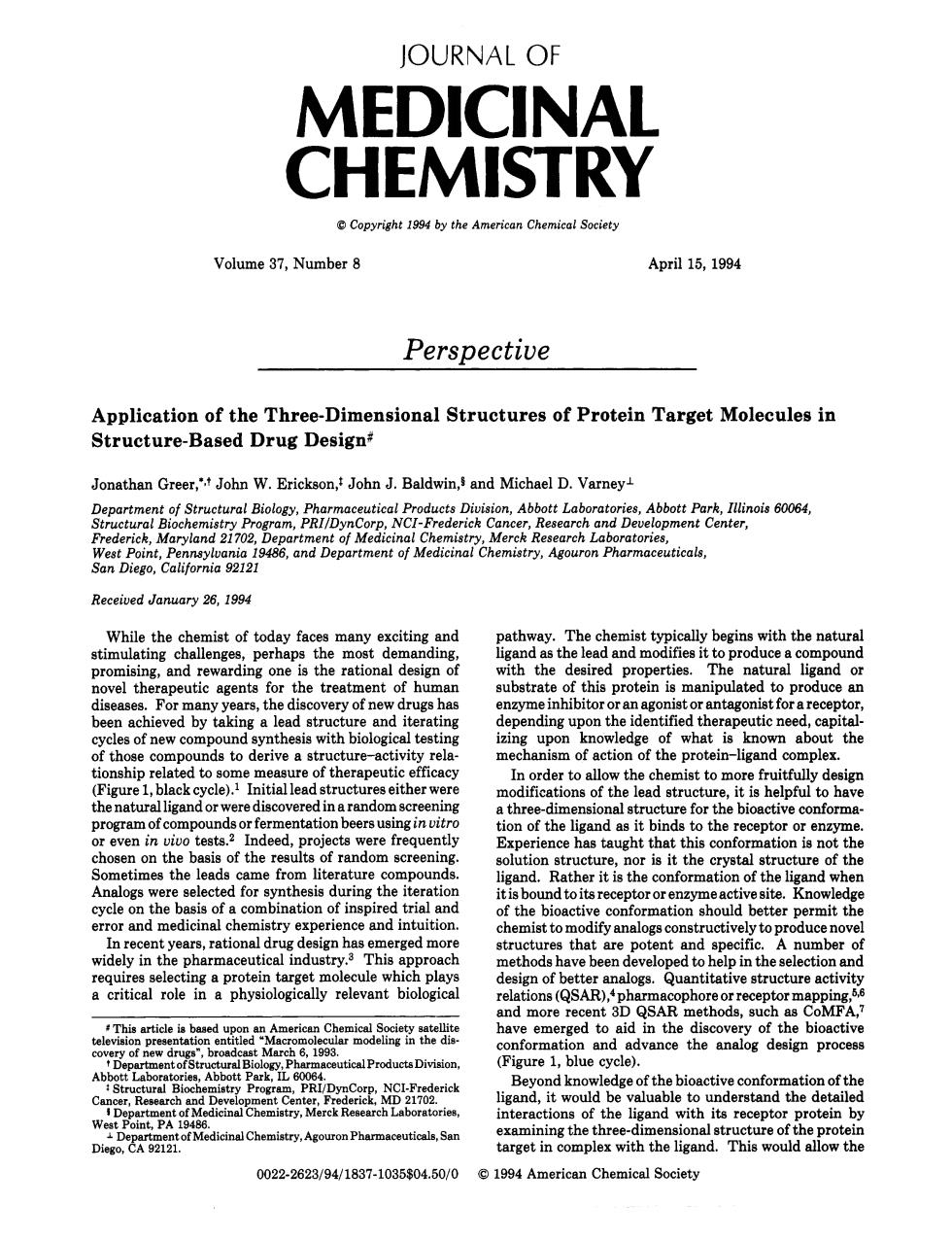正在加载图片...

JOURNAL OF MEDICINAL CHEMISTRY Copyright 199 by the American Chemical Society Volume 37,Number 8 Apr115.1994 Perspective Application of the Three-Dimensional Structures of Protein Target Molecules in Structure-Based Drug Design Jonathan Greer,'.t John W.Erickson,John J.Baldwin,and Michael D.Varney 702 gra Received January 26,1994 athu cally begins with the natural and as the produceac mpound trate of this protens edto produce ars,the disco ery of nev gs ha of what is known about the ds to derive a str utic m01 tio s either wer it is helpful to av three- the bio tive conforma tdedprojlectserefreauent Exp iencehas taught that this conform tion is not the ature mpoun whe ed tria itoitsreceptororenzyTmeaG ve site rror and medicina stry exp ience and int hemist to mo uctive to produceno This ign of 0g8 Quantitative tr e activit a cr OgADYA-1 nd more recent 3D QSAR and advance the of nev tical Products Divisior (Figure 1,blue cycle) try. eraction target in comple with the ligand.Thisould alow the 0022-2623/94/1837-1035804.50/0 @1994 American Chemical Society JOURNAL OF MEDICINAL CHEMISTRY 8 Copyright 1994 by the American Chemical Society Volume 37, Number 8 April 15, 1994 Perspective Application of the Three-Dimensional Structures of Protein Target Molecules in Structure-Based Drug Design# Jonathan Greer,*i+ John W. Erickson,t John J. Baldwin,$ and Michael D. Varneyl Department of Structural Biology, Pharmaceutical Products Division, Abbott Laboratories, Abbott Park, Illinois 60064, Structural Biochemistry Program, PRIIDynCorp, NCI-Frederick Cancer, Research and Development Center, Frederick, Maryland 21 702, Department of Medicinal Chemistry, Merck Research Laboratories, West Point, Pennsylvania 19486, and Department of Medicinal Chemistry, Agouron Pharmaceuticals, San Diego, California 92121 Received January 26, 1994 While the chemist of today faces many exciting and stimulating challenges, perhaps the most demanding, promising, and rewarding one is the rational design of novel therapeutic agents for the treatment of human diseases. For many years, the discovery of new drugs has been achieved by taking a lead structure and iterating cycles of new compound synthesis with biological testing of those compounds to derive a structure-activity relationship related to some measure of therapeutic efficacy (Figure 1, black cycle).l Initial lead structures either were the natural ligand or were discovered in a random screening program of compounds or fermentation beers using in vitro or even in vivo tests.2 Indeed, projects were frequently chosen on the basis of the results of random screening. Sometimes the leads came from literature compounds. Analogs were selected for synthesis during the iteration cycle on the basis of a combination of inspired trial and error and medicinal chemistry experience and intuition. In recent years, rational drug design has emerged more widely in the pharmaceutical ind~stry.~ This approach requires selecting a protein target molecule which plays a critical role in a physiologically relevant biological #This article is based upon an American Chemical Society satellite television presentation entitled "Macromolecular modeling in the discovery of new drugs", broadcast March 6, 1993. t Department of StruduralBiology, PharmaceuticalProductsDivision, Abbott Laboratories, Abbott Park, IL 60064. f Structural Biochemistry Program, PRI/DynCorp, NCI-Frederick Cancer, Research and Development Center, Frederick, MD 21702. f Department of Medicinal Chemistry, Merck Research Laboratories, West Point, PA 19486. I Department of Medicinal Chemistry, Agouron Pharmaceuticals, San Diego, CA 92121. 0022-262319411837-1035$04.50/0 pathway. The chemist typically begins with the natural ligand as the lead and modifies it to produce a compound with the desired properties. The natural ligand or substrate of this protein is manipulated to produce an enzyme inhibitor or an agonist or antagonist for a receptor, depending upon the identified therapeutic need, capitalizing upon knowledge of what is known about the mechanism of action of the protein-ligand complex. In order to allow the chemist to more fruitfully design modifications of the lead structure, it is helpful to have a three-dimensional structure for the bioactive conformation of the ligand as it binds to the receptor or enzyme. Experience has taught that this conformation is not the solution structure, nor is it the crystal structure of the ligand. Rather it is the conformation of the ligand when it is bound to its receptor or enzyme active site. Knowledge of the bioactive conformation should better permit the chemist to modify analogs constructively to produce novel structures that are potent and specific. A number of methods have been developed to help in the selection and design of better analogs. Quantitative structure activity relations (QSAR),4pharmacophore or receptor mapping,6t8 and more recent 3D QSAR methods, such as CoMFA? have emerged to aid in the discovery of the bioactive conformation and advance the analog design process (Figure 1, blue cycle). Beyond knowledge of the bioactive conformation of the ligand, it would be valuable to understand the detailed interactions of the ligand with its receptor protein by examining the three-dimensional structure of the protein target in complex with the ligand. This would allow the 0 1994 American Chemical Society